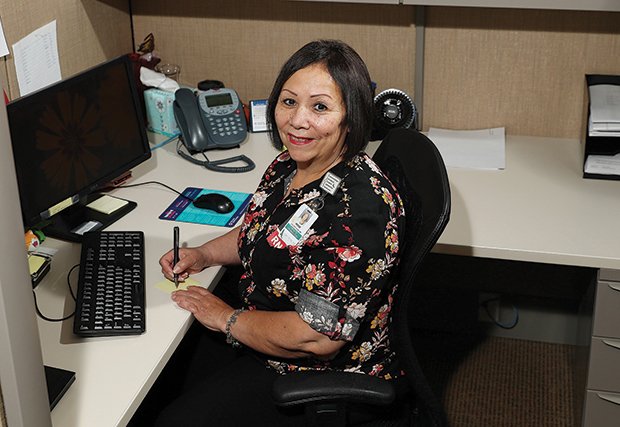Outpatient rehabilitation at Fort Duncan plays a key role in recovery after carpal tunnel surgery
There’s a slim passageway of ligament and bones at the base of the hand called the carpal tunnel. Even though it’s a relatively small spot on the body, when something goes wrong there it can have a big impact. Irene Lerma knows that all too well. As a Clinical Documentation Improvement Specialist at Fort Duncan Regional Medical Center, Lerma spends much of her day on the keyboard. But when performing basic tasks like typing became increasingly difficult, she knew something had to be done.
“Doing my job was painful,” she says. “It wasn’t just a problem at work, but at home, too,” she adds. “Straightening my hair, washing the dishes, trying to lift a pan – doing all of these things hurt. I would get up in the morning and the pain would start and then it would just get worse throughout the day.”
Lerma had carpal tunnel syndrome, a painful condition that results when the median nerve running through that small passageway becomes compressed. “In addition to feeling pain, I also experienced numbness and tingling in my fingers and it radiated up to my elbow,” she says.
Surgery provided some immediate relief, but a big part of a successful recovery includes physical therapy. That’s where the Outpatient Rehabilitation Services Center at Fort Duncan came in. Just four days after her operation, Lerma was at her first rehab appointment.
Learn more about outpatient rehabilitation >
“We try to make the transition to therapy a seamless process,” says Elena Angus, Director Outpatient Rehab Services. “We start with an initial evaluation to determine how many visits the patient will need and to develop an individualized care plan. We also provide guidance right away on what to do at home. That’s very important.”
Results came quickly. “I noticed a difference right away,” Lerma says. “The first time I went in they wanted to see how far I could bend my wrist, how much strength I had in my hand and if I was able to grasp things with my fingers. As the appointments went by, I would feel less and less pain and I could do more. They also gave me information on what to do at home.”
Angus emphasizes that patient education is a big part of the rehabilitation process. “We believe that if a patient understands what is going on with their bodies, they will be more motivated to participate in their plan of care,” she says.
The director is also quick to point out that the patient makes all the difference. “Number one is they really need to work at what the physical therapist tells them to do,” she says. “We’re only guiding them. Their work is what’s important. They have to participate and really follow the care plan.”
Lerma’s commitment to rehabilitation and hard work paid off. “I feel good,” she says. “I can go through the whole day without pain.”
An inside look at outpatient rehab
Elena Angus, Director Outpatient Rehab Services, shares more ways the outpatient team helps PT patients feel comfortable:
“We are focused on the community. Patients don’t have to travel for physical therapy. It’s right here. Being close to home can have a positive impact on recovery.”
“Our location is convenient. We are located just behind the main hospital in an easily accessible, first-floor location.”
“Patient education is a big part of what we do. We have a system that prints out instructions with pictures so patients know exactly how to follow the at-home program we prepare for them.”
“Our care is individualized. All of the therapy that we provide is one-on-one. Patients get the full attention of the therapist working with them while they are here.”

